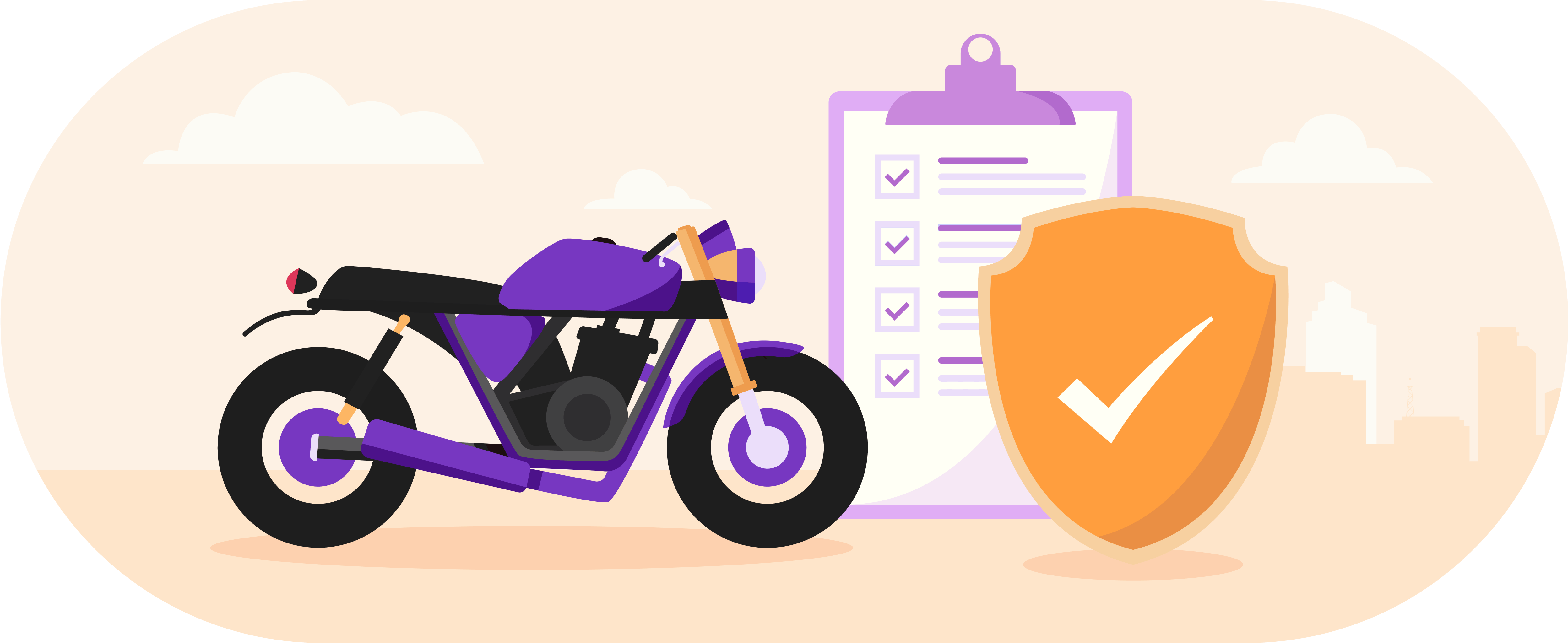
Meet Rajiv, a bike enthusiast who lives for the thrill of the open road. One day, he set off on an adventure with friends. But fate had a different plan. He met with an accident, leaving his bike damaged.
To make matters worse, Rajiv realised his insurance had expired just a week earlier. His story is a reminder: having active bike insurance is more than just a chore—it’s your safety net for the unexpected twists of life on the road. So, before your next ride, double-check your insurance to ensure a worry-free journey. After all, every adventure is better when you know you’re covered.
Here’s a comprehensive checklist to make sure you have the right bike insurance with you.
Evaluating The Types Of Bike Insurance You Need
Third-Party Insurance:
- Mandatory by Law: It’s a must-have, according to the law. It covers costs if you’re involved in an accident causing injury to other people, vehicles, or properties.
- Fixed Rates: The government sets the prices, so they’re the same no matter which insurer you choose.
Comprehensive Insurance:
- All-in-One Protection: This covers everything from third-party liabilities to your bike’s damages from accidents, theft, or natural disasters.
- Extra Protection Available: You can boost your coverage with add-ons like Zero Depreciation.
Check The List Of Essential Add-ons:
- Personal Accident Cover: Extra safety for you against accidental injuries.
- Zero Depreciation Cover: No deduction for depreciation when you make a claim.
- Engine Protect Cover: Protection for your bike’s engine.
- NCB Protection Cover: Keeps your No Claim Bonus even after a claim.
- Pillion Cover : Covers your passenger against bodily injuries and death, too.
- Accessories Coverage: Protects your accessories like helmets and carriers.
Documents Required To Buy A Bike Insurance
To initiate the purchase/renewal of two-wheeler insurance, the vehicle owner would need the following list of documents :
- Who The Owner Is : Share a valid ID, like a PAN card, passport, driver’s license, or Aadhaar card.
- Where The Owner Lives : Prove it with an address document—passport, driver’s license, voter ID card, or Aadhaar card. (If CKYC is not already completed.)
- Bike’s ID Card (RC): Bring your motorcycle’s original Registration Certificate (RC).
- Passport Size Photographs: Attach one recent passport-size picture of the owner and the bike.
- Previous Policy Details: Dust off the old policy number. It’s part of insurance history.
Check the policy details for accuracy, and don’t hesitate to ask your insurance provider if you have questions.
A Guide To Policy Renewals
Renewing your bike insurance is easy and convenient. You can renew online through your insurer’s website, mobile apps, SMS/Whatsapp services, or comparison sites. Or, you can visit a branch office, contact your agent, or call customer service for offline renewal. Generally, there are no additional charges for online policy renewal, but offline renewal may involve administrative fees.
Here’s an easy guide to ensure your bike stays protected:
- Check The Grace Period: See how much time you have; it’s usually up to 90 days after expiration. No rush, but don’t miss out on benefits like the No Claim Bonus (NCB).
- Hop Online: Visit your old insurer’s website or explore other mobile insurance apps. Fill in your bike details and information from your previous policy.
- Pick Your Policy: Choose a plan that suits you, whether a basic liability, comprehensive bike insurance policy, or zero depreciation policy, which can be a game-changer if you want full coverage without worrying about depreciation. Look out for discounts that can help lower your premium while still giving you good coverage. The key is finding the right plan to hit the road confidently.
- Value Your Bike & Select the IDV: Set the Insured Declared Value (IDV) to reflect your bike’s current market worth. Remember, IDV is influenced by factors like your bike’s age and condition. Ensure your IDV accurately represents your bike’s value to ensure adequate coverage. So, when deciding on your IDV, remember these factors to ensure your bike is properly covered for its actual value.
- Pay Online: Pay up using your preferred online method and wait for the policy message to be received in your email.
- Check Twice: Once you’ve got that policy document, give it a once-over. If anything seems off, reach out to the insurer to fix it.
You can tweak your coverage to suit your needs when renewing your policy. You can add extras like roadside assistance or NCB discounts, which could bump your premiums but offer added peace of mind. On the flip side, if you do not need certain add-ons, you can trim them to lower your costs. Remember, each change you make affects what you’re covered for and how much you pay, so it’s worth trying to find the right balance between protection and budget.
Understanding The Bike Insurance Claim Process
Alright, let’s break down the bike insurance claim process in simple terms:
- Inform The Insurance Company: Contact your insurer via the service center, or customer care, or visit the insurer’s nearest branch directly. Provide details of the incident, including when, where, and what happened. Before contacting your insurer, document the damage to your bike by taking photos or videos of the scene. These visuals will be valuable evidence for your claim.
- File A Claim: Fill out the claim form and gather the necessary documents, including a copy of your insurance policy, bike registration certificate (RC), driver’s license, and, if things get serious, an FIR (especially for theft or accidents). Depending on the insurer’s options, the claim process can be initiated online or through the branch.
- Assessment Of The Claim: The insurance company will send a surveyor to check your bike and assess the damage if your policy covers it. Approval depends on factors like the extent of damage and policy terms. Claims may be rejected if the damage isn’t covered or documentation is incomplete or inaccurate.
- Settlement Of The Claim: If your claim is approved, the insurance company will settle based on your policy terms. Settlement can be cashless or through reimbursement, depending on the insurer. Cashless means they foot the repair bills directly. With reimbursement, you front the money for repairs, then send them the bills for a refund.
Why You Should Explore Purchasing or Renewing Bike Insurance Online?
- Quick and Easy
- Transparent comparison and information
- No Hidden Fees
- No Inspections or Extra Paperwork: Hassle-free renewal process.
- No Need for Old Policy Details: Even if your old policy expired over 90 days ago. (However to avail NCB benefits, old policy details are required.)
- Fast Claims Settlement: Get help with claims whenever you need it.
- Round-the-Clock Support
Key Takeaways
That’s all. Keep these checklists handy to ensure you have the right bike insurance and full coverage as and when required. Renewing your two-wheeler insurance online isn’t just convenient; it’s a smart way to ensure your ride stays protected without any hassle. Additionally, consider platforms like PhonePe for a seamless and hassle-free insurance purchase experience.
Frequently Asked Questions
Does PhonePe offer any discounts on purchasing bike insurance policy from their platform ?
Is it better to buy a bike insurance policy online as compared to offline ?
How to choose the best insurer among so many available options for purchasing a bike insurance policy ?
How is Claim settlement ratio of an insurer different from its Claim incurred ratio ?
What to do in case my bike breaks down and there is no network garage of my insurer nearby ?
